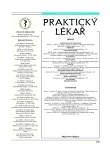Diagnosis and therapy of tracheal stenosis
Authors:
M. Šteffl 1; V. Válek 2
Authors‘ workplace:
ORL odd. FN Brno Bohunice, primář MUDr. A. Trnka
1; Radiodiagnostická klinika FN Brno Bohunice, přednosta
prof. MUDr. Vl. Válek, CSc.
2
Published in:
Prakt. Lék. 2005; 85(8): 441-444
Category:
Of different specialties
Overview
Background.
The problem of subglottic and tracheal stenosis is a problem that is amenable to various treatment modalities. Two treatment modalities prevail, endoscopic and external. The indication for each modality is not yet clearly defined.
Methods and Results.
A group of 98 patients suffering tracheal stenosis was studied in the period from January 1994 till December 2004. The stenting procedure was performed in 40 patients, tracheal resection with anastomosis in 20 cases and other endoscopic interventions in 38 patients. Over 10 years the authors introduced 36 Palmaz stents (max. in 4 patients 102 months), 12 Polyflex stents, 4 Wall stents and 1 Z stent. Other patients were treated with carbon dioxide laser and high pressure balon dilatation.
Conclusions.
Based on our long-term experience, open surgery in chronic benign tracheal stenosis is the treatment of choice. However, if contraindications to open surgery exist, whether local or general, endoscopy with stenting by using Palmaz or Polyflex stents, laser-assisted endoscopy or balon dilatation, can offer good palliative results.
Key words:
tracheal stenosis – tracheal stent – tracheal resection – laser – tracheal dilatation.
Labels
General practitioner for children and adolescents General practitioner for adultsArticle was published in
General Practitioner

2005 Issue 8
Most read in this issue
- Bacterial immunomodulators
- Antibiotics and their application in pregnancy
- Diagnosis and therapy of tracheal stenosis
- Type A aortic dissection, case reports
